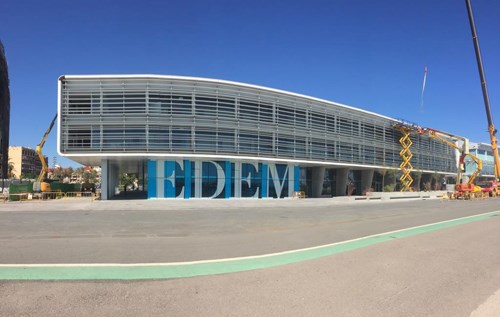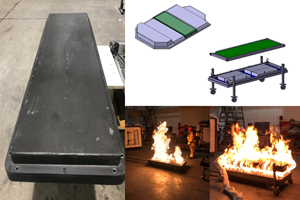An FRP facelift
When the University of Valencia's business school expanded its facilities, it turned to fire-rated composite structures to fabricate the 7000-sq-m of façade used to help modernize the structures.

The EDEM Escuela de Empresarios Business School at the University of Valencia recently expanded into three harbor buildings, which now feature 7,000m2 of fire-rated composite façade.
The EDEM Escuela de Empresarios Business School, at the University of Valencia (Valencia, Spain), is a private non-profit foundation, set up in 2002 to support the business sector training future business leaders, executives and entrepreneurs. As part of a major expansion of the school, three harbor buildings that were formerly part of the Port of Valencia have been combined, redesigned and refurbished inside and out, and now feature a modern new façade manufactured from a fire-rated all-composite system.
The new EDEM building, officially opened in September 2015, was designed by the Spanish architect D. Jose Marti, principal architect of R Studio Arquitectura (Valencia). Marti’s design vision has created a modern new learning and study environment, with open spaces, natural light and panoramic waterfront views across the harbor. The new 7,000m2 façade, which covers the entire length of the original three buildings, is constructed from a composite system using Scott Bader Company Ltd.’s Crestapol 1212 high-performance acrylic resin for all parts. The façade comprises of 15,000m of FRP pultruded profiles and 2,050 moulded parts with 100 shape and size combinations; each composite part had to pass the EN UNE 13501-1 Cs2d0 fire standard.
The new exterior building design has areas with traditional flat wall panel cladding, but is largely made up of elliptical slats in front of new floor-to-ceiling windows. The horizontal and vertical composite slating system used in different sections of the new façade offers a shutter-like appearance, providing natural daylight and shade, preventing the building from overheating during hot summer months.
A critical factor in resin matrix selection was the high filler loading of 170 phr by weight of alumina trihydrate (ATH) needed to pass the EN UNE 13501 fire specification. As such, Crestapol 1212 was specified and used to produce all of the 2,050 molded parts as well as the 15,000m of GRP pultruded profiles.
The production of all the molded components for the new façade was carried out by Miraplas S.L. at its purpose-built 44,000m2 factory in Monforte del Cid, in southern Spain. The three production methods used by Miraplas were hand lay-up, light resin transfer molding (RTM) and compression moulding. A total of 1,200 flat sandwich cladding panels was fabricated (light RTM and compression molding), each 30 mm thick, in various lengths and widths. The panels feature the same cored laminate design, with alumina trihydrate (ATH)-filled Crestapol 1212 resin, a rigid 25-mm polyisocyanurate (PIR) insulation core and ROVICORE FR glass fiber reinforcements in the sandwich outer skins.

The façade features 2,050 molded composite parts and 15,000m of pultruded profiles. The key to meeting fire resistance requirements was the use of alumina trihydrade (ATH) in Scott Bader's Crestapol 1212 acrylic resin matrix.
Around 800 elliptical L-shaped vertical support slats were produced by RTM to the same sandwich laminate specification. The remaining 50 GRP parts used to cover sections of the structural steel building frame and provide mechanical fixings points for the GRP sandwich cladding panels and slats, use a conventional monolithic glass fiber-reinforced specification, but again had to be EN fire rated, so all of these hand lay-up molded parts used Crestapol 1212 170phr ATH-filled as the specified resin.
Antonio Mira, general manager, Miraplas S.L., says, “Being able to use Crestapol for this major project with so many different parts, whatever the production process, was a big help for productivity and gave us increased confidence that each of the 2,050 parts would meet the EN fire rating and still achieve the lightweight specification and mechanical properties needed for this project. Miraplas has worked with Crestapol 1212 on other building façade projects and we know we can produce complex shaped lightweight parts which have excellent long-term performance.”
The 15,000m of pultruded profiles, also required in a variety of dimensions and profile shapes, were subcontracted to Polymec S.L. and Tecnipul Composites S.L.
Related Content
Price, performance, protection: EV battery enclosures, Part 1
Composite technologies are growing in use as suppliers continue efforts to meet more demanding requirements for EV battery enclosures.
Read MorePlant tour: Albany Engineered Composites, Rochester, N.H., U.S.
Efficient, high-quality, well-controlled composites manufacturing at volume is the mantra for this 3D weaving specialist.
Read MorePEEK vs. PEKK vs. PAEK and continuous compression molding
Suppliers of thermoplastics and carbon fiber chime in regarding PEEK vs. PEKK, and now PAEK, as well as in-situ consolidation — the supply chain for thermoplastic tape composites continues to evolve.
Read MoreA new era for ceramic matrix composites
CMC is expanding, with new fiber production in Europe, faster processes and higher temperature materials enabling applications for industry, hypersonics and New Space.
Read MoreRead Next
CW’s 2024 Top Shops survey offers new approach to benchmarking
Respondents that complete the survey by April 30, 2024, have the chance to be recognized as an honoree.
Read MoreFrom the CW Archives: The tale of the thermoplastic cryotank
In 2006, guest columnist Bob Hartunian related the story of his efforts two decades prior, while at McDonnell Douglas, to develop a thermoplastic composite crytank for hydrogen storage. He learned a lot of lessons.
Read MoreComposites end markets: Energy (2024)
Composites are used widely in oil/gas, wind and other renewable energy applications. Despite market challenges, growth potential and innovation for composites continue.
Read More

















.jpg;maxWidth=300;quality=90)








